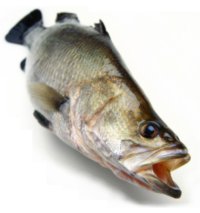
Barramundi - industry profile

Background
The barramundi (Lates calcarifer) is a large predatory fish native to QLD, NT and WA. It is cultured world wide, often marketed or farmed as "sea bass".
The colder climate, elevated heating costs of tank culture, as well as site restrictions of the NSW Barramundi Farming Policy, have managed the development of this industry in NSW. However, this species is one of the few proven economically for recirculation tank systems, and the NSW barramundi farming industry is performing strongly.
Production Trends
Barramundi can only be grown in recirculation aquaculture tanks in NSW, due to temperature requirements and provisions of the NSW Barramundi Farming Policy. The optimum temperature for barramundi culture is 28°C, with acceptable growth rates between 26-30°C. At optimum temperatures, barramundi can be raised to market size (500g) within 6-12 months. Barramundi production in NSW has risen rapidly over past years, with a few farms expanding production capabilities. For the production figures see the NSW DPI aquaculture production reports.
Market/Price trends and Opportunities
Barramundi is well known and relatively established in seafood markets. Farmed barramundi is sold as live (400-800g), plate size whole (300-500g), and fillets or larger whole fish (2kg) products. Most barramundi produced in NSW is sold as live or whole chilled. Higher prices have readily been achieved for live fish, however this market is quickly saturated by local and interstate product, and growers are increasingly being forced to look for alternatives. Little value adding or post harvest processing has been done with NSW product to date.
Average farm gate prices for NSW barramundi have fluctuated over past years, with no consistent trends. In comparison, prices across the Sydney Fish Market floor of Australian farmed barramundi has shown a downward trend. For the production figures see the NSW DPI aquaculture production reports. It is expected that supply onto the domestic market of barramundi will increase substantially over the next decade, from the development of a large farm in NT and expansion to QLD and NSW production. Cheap imports from Asia may also affect market prices for NSW farmers, as well as continued or increased imports of white flesh fillets, particularly Nile perch which are very similar to barramundi, but cheaper.
Export market opportunities are likely to be limited, due to the higher cost of producing fish in Australia compared to Asia . Some farmers have commenced supplying fillets to supermarket chains, however NSW farms generally do not have critical mass yet to enter this market. As a result a large proportion is sold directly to restaurants and live fish traders.
Investors can obtain some marketing information from the Australian Barramundi Farmers Association (www.abfa.info) which also provides good industry networks. Reports available include:
ABFA. Proceedings of the Farmed Barramundi Marketing Workshop .
Ruello and Associates, 2000. Situation Analysis of Farmed Barramundi Marketing . Report for the Australian Barramundi Farmers Association and Queensland Department of Primary Industries.
Ruello and Associates, 1997. The Handling and Value Adding of Farmed Barramundi. Report to the National Seafood Council and the Australian Barramundi Farmers Association.
ABARE, 2002. Import Competitiveness of Australian Aquaculture . Report to the Fisheries Resources Research Fund.
Up to date and historical auction prices (daily and monthly) from the Sydney Fish Market can be obtained from the following website: www.sydneyfishmarket.com.au .
Economics - Models and Information
Recirculation aquaculture technology is capital intensive to establish and operate. The performance of recirculation technology in Australia has been poor and unproven for most species, although barramundi has a more positive track record for this technology. There are tools available to assist investors including the interactive model 'Barraprofit Economic Information Package' developed by the QDPI.
Investors should obtain a copy of Barraprofit and evaluate the proposal using the recirculation model. The model will take into account all factors of production from purchasing and stocking fingerlings to harvest, however investors will need an accurate idea of production costs for an effective analysis.
Other economic data can be obtained from the report:
RIRDC, 1998. The New Rural Industries - A Handbook for Farmers and Investors .

